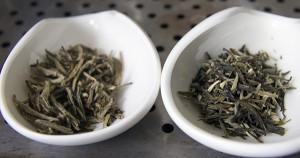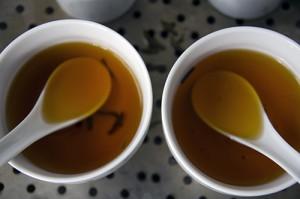If you have been to any traditional Chinese tea shop- especially the larger ones- you might notice that when you ask for a variety like say Tieguanyin or Longjing, you have more than one choice and the difference in price can be rather significant.
In fact in China, when you ask for a tea, one of the first questions they ask is your budget.
To put it into context, for Tieguanyin you might be able to get something at less than $10 per 100g or you could easily pay $1000 for the same quantity.
The difference is not in the greed of the merchant but the “grade” of tea. (Of course sometimes greed is a factor, hey, we don’t live in a utopian world)
Before we go further into why “grades” exist, let us define the nomenclature.
This doesn’t mean “grade” as the British system of grading (OP, FTGFOP, TGFOP1 etc.) which are essentially a measurement of leaf size and wholeness, which really is largely useless for assessment of production quality. Well, maybe for black tea it is slightly useful since the level of skill required for production is lower than green tea and oolong tea.
While there is some overlap with the Chinese system of grading which is more indicative of production quality- covering appearance (where it relates to productions standards), aroma and taste- the ‘grades’ that I am referring probably better explained by ‘tier’.
For example, hypothetically I might have a $24, a $35 and a $45 Tieguanyin. This is in consideration of all 3 being say 2013 Spring Tieguanyin as opposed to an autumn one or one from 2012.
This would be 3 different grades or tiers- I won’t go into the Chinese system of grading to avoid confusing the issue- for the same tea.
The Argument against ‘Tiers’

“Why don’t you sell the best of everything instead of confusing the customer?”
The simple answer is the best cost money, more than what some segments might be willing to pay and also the “best” as we understand “best”- i.e. a measurable empirical superiority instead of the merchant’s personal favorite- is out of reach of us foreigners.
Let me give a simple illustration.
How do you determine what is the best? By holding a competition.
In a Tieguanyin tea competition for example, the judge will go through different batches submitted that year. When he declares one particular numbered batch the ‘winner’, it is immediately sealed, either sent to some party official or readied for auction.
Whoever claims to sell the “best” Tieguanyin either choses to redefine “best” or is a charitable organization, paying more than the equivalent weight in goal and selling to you at a bargain.
If it is what the seller claims to be his idea of “best” then a subjective “best” is actually meaningless, no?
Different Strokes for Different Folks- why merchants sell different tiers
The simple reason is that people have different aspired qualities.
I have often made the point that if you are just starting out in tea, there is no need to go for the best. Between brewing techniques, equipment, sensitivity, you won’t get the most out of it. Of course if you start with lousy tea then you might just choose a new hobby.
There is also a matter that most of us who don’t count oil fields as our property have a budget. Some more lavish than others but most of the time, there is a ceiling.
Drinking a $100 per 50g tea is immensely gratifying but for regular daily consumption, it will soon affect our children’s education fund.
Hence staying on my Tieguanyin example, if someone is new or new to quality Tieguanyin- forget those restaurant quality or mass market offerings- a $24 one would suffice to captivate, enchant and yet not prove prohibitive for daily consumption, at least when compared to the $45 one.
Why do producers produce different tiers?
The simple answer is you can’t control nature.
Let us look at Tieguanyin again.
It goes through these simplified stages:
- Picking
- Withering
- ‘Zuo Qing’- combination of rattling and settling
- ‘Shaqing’- destroy enzymes through heat
- Rolling/Shaping
- Drying

i) Where it was grown, even within the same field (shaded or not)
ii) If it was raining when the leaves are picked, value plummets
iii) What time of the day it was picked
iv) How it grows- i.e. size, health, sturdiness etc.
v) Damage by pest?
So from this point onwards, the leaves are further segregated.
As fine Tieguanyin is largely manually processed, the more ‘qualified’ tea masters get the better leaves and the gap widens.
If it rains or the climate becomes unsuited for ‘zuo qing’, the grade changes.
All these variables are made with the assumption that the production is perfect which is idealistic since human errors might occur to lower the grade.
Do Tea Drinkers Need Different Grades?
Is there a need for tea lovers to get the different grades of the same variety of tea?
Well, assuming that you are able to get different grades of the same tea, this is actually a very good exercise.
Comparing teas of the same kind- i.e. Tieguanyin for example- across different grades is a good way of learning to discern quality tea.

Compare the more expensive versus the cheaper tea.
Compare the body, mouth feel, aftertaste, aroma and so forth.
You should then be able to get a good idea of what a good tea should be. For comparability, it would help to get from the same vendor because you would be subjected less to the variation of the vendor’s own markup.
After a while, you should get a better handle of what is a higher quality tea.
Of course if you can’t tell any difference, then go for the cheaper one- this may be a combination of a few factors
- Vendor is stiffing you
- Your palates have yet to develop the sensitivity
- Differences are too minor to discern
In any case, save money and buy the cheaper one.
Now which other vendor tells you that? :p
See other articles on Selection and Storage of Tea
See more articles on Tea Appreciation here
